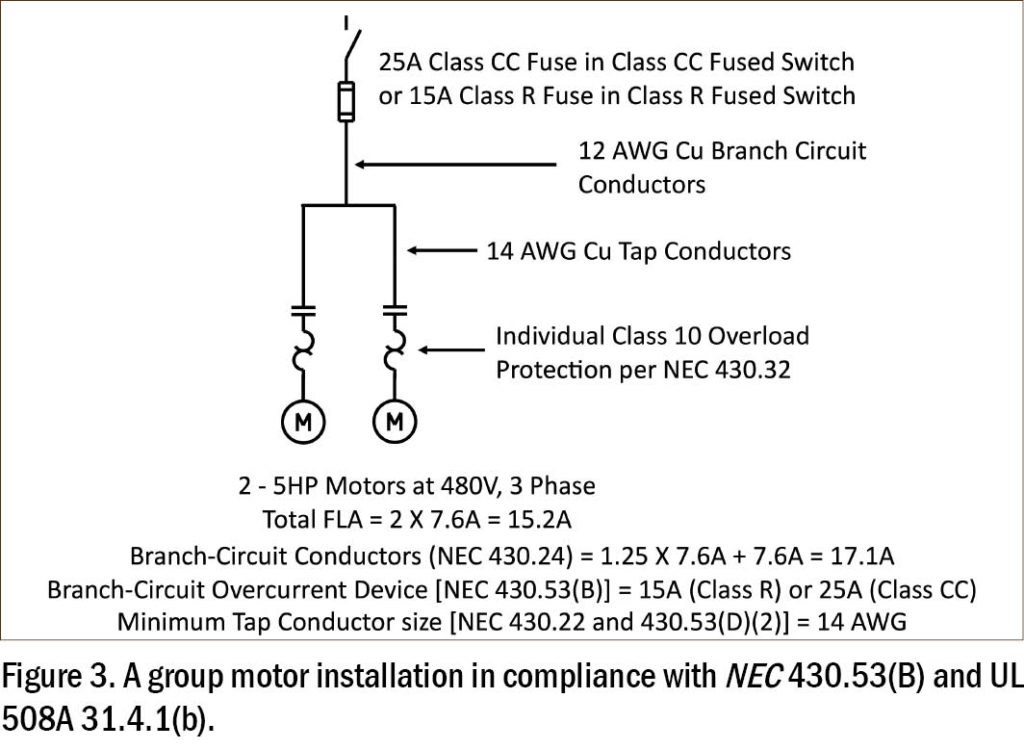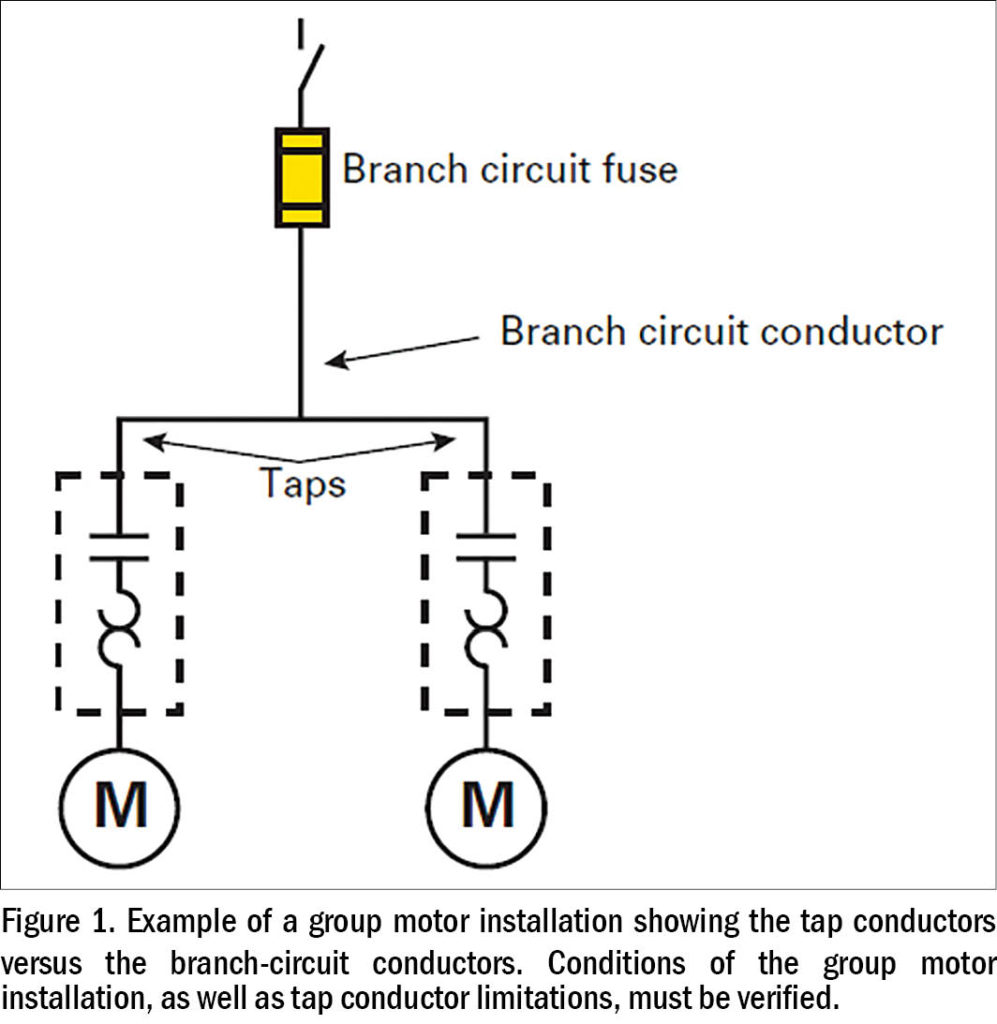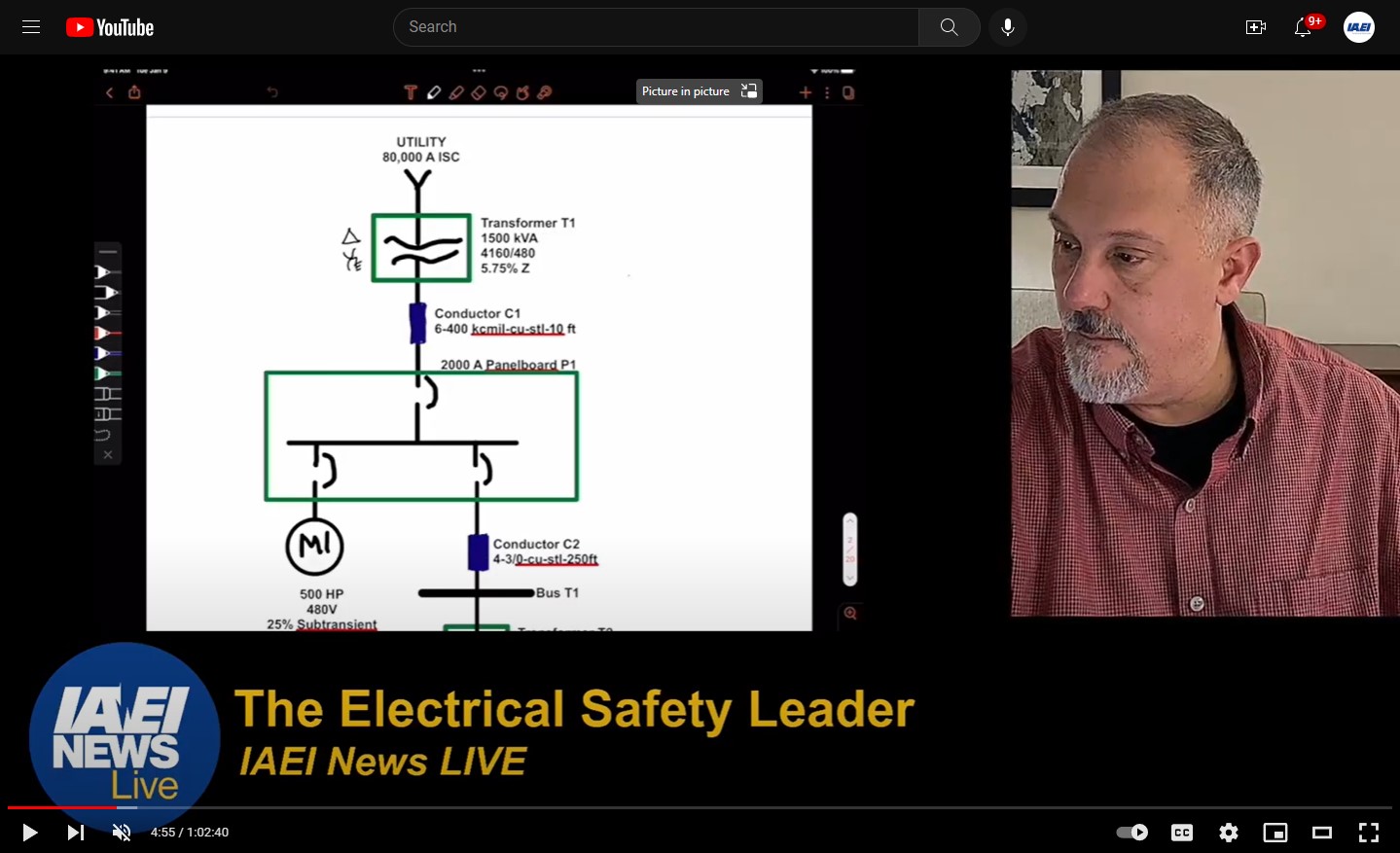There are instances where several motors (and other loads, if needed) are installed on a single branch circuit. Specific requirements for this application are detailed in the National Electrical Code (NEC) for general installations and UL 508A, Standard for Industrial Control Panels, for these applications. This configuration is commonly referred to as a “group motor installation.”
The benefit of group motor installations is that only one branch-circuit overcurrent protective device (fuse or listed inverse-time circuit breaker) is required to provide short-circuit protection for all motor controllers or overload protection devices in the group. This will potentially reduce overall cost and space requirements. However, the NEC and UL provide strict limitations on these applications. The restrictions include acceptable conditions and limitations on the minimum rating of the tap conductors from the branch-circuit conductor to the motor controller. NEC 430.53 and Section 31.4.1 in UL 508A identify three basic conditions that are acceptable for group motor installations.
The three possible acceptable conditions for group motor installations are:
A) Groups of motors (1 hp or less) where the branch-circuit overcurrent protective device for the group does not exceed 15 A or 20 A at 120 VAC.
B) Groups of motors where the branch-circuit overcurrent protective device for the group is sized the same as a single motor application for the smallest motor in the group.
C) Groups of motors where the motor controllers are marked “suitable for group installations,” and the branch-circuit overcurrent protective device meets all motor controller marking for type and rating.
We’ll explore additional requirements for each of the applications above, such as overload protection provided for all motors. In addition, all three types of group motor installations must meet additional conductor tap rules per NEC 430.53(D) and UL 508A Section 31.4.3—these requirements may be the most restrictive and often overlooked.
Conductor Tap Rules
It is important to distinguish the branch-circuit conductors from the tap conductors and ensure that the tap conductors are adequately sized based on NEC or UL 508A rules. For the NEC, the four possible options to meet the proper sizing of the tap conductors are:
1) The ampacity of the conductors from the point of the tap to the motor are not less than the branch-circuit conductor ampacity.
2) The ampacity of the conductors from the point of the tap to the motor are not less than 1/3 of the branch-circuit conductor ampacity and not less than 125 percent of the motor full-load current rating (based on Tables 430.247 to 430.250). The conductors from the point of the tap to the motor overload device are 25 feet or less and protected from damage.
3) The ampacity of the conductors from the point of the tap are not less than 1/10 of the branch-circuit overcurrent protective device rating or setting and terminate in a listed manual motor controller additionally marked “Suitable for Tap Conductor Protection in Group Installations” or a listed branch-circuit overcurrent protective device. The conductors from the point of the tap to the motor controller or branch-circuit overcurrent protective device are either (1) 10 feet or less in length and protected from damage or (2) the same ampacity as the branch-circuit conductors. The conductors from the motor controller or branch-circuit overcurrent protective device to the motor or other load are not less than 125 percent of the full-load current rating of the motor or load (based on Tables 430.247 to 430.250).
4) The ampacity of the conductors from the point of the tap are not less than 1/3 of the branch-circuit overcurrent protective device rating or setting and terminate in a listed manual motor controller additionally marked “Suitable for Tap Conductor Protection in Group Installations” or a listed branch-circuit overcurrent protective device. The conductors from the point of the tap to the motor controller or branch-circuit overcurrent protective device are either (1) 25 feet or less in length and protected from damage or (2) the same ampacity as the branch-circuit conductors. The conductors from the motor controller or branch-circuit overcurrent device to the motor or other load are not less than 125 percent of the full-load current rating of the motor or load (based on Tables 430.247 to 430.250).
The first option recognizes that if the ampacity of the conductors from the point of the tap to the motor have the same ampacity as the branch-circuit conductors, then they are technically not tap conductors.
Option 2 allows the ampacity of the conductors from the point of the tap to the motor to have an ampacity of up to 1/3 of the branch-circuit conductor ampacity, but not less than 125 percent of the full-load current rating of the motor—provided these conductors are 25 feet or less and protected from damage. Section 31.4.3 in UL 508A has a similar provision that requires the ampacity of the tap conductors and the internal conductors to individual loads to have an ampacity of up to 1/3 of the branch-circuit conductors. The branch-circuit conductors supplying the group motor installation are sized based on 125 percent of the largest motor plus 100 percent of all other loads. The minimum wiring size is 14 AWG with internal wiring required to have an ampacity adequate (100 percent) for the load, whereas terminations for field wiring are sized at 125 percent of the load. There is no length restriction or protection from damage since these conductors will be installed in an industrial control panel or field-installed, according to the requirements in the NEC.
Option 3 allows the ampacity of the conductors from the point of the tap to a listed manual motor controller marked “Suitable for Tap Conductor Protection in Group Installations” which can only supply a single motor or a branch-circuit overcurrent protective device when supplying other loads, to be up to 1/10 of the ampacity of the branch-circuit overcurrent protective device rating. Note: In this condition, the reduction in ampacity is based on the branch-circuit overcurrent protective device rating, NOT the branch-circuit conductor ampacity. Although not directly stated, the ampacity of these conductors must be not less than 125 percent of the full-load current rating of the motor or load. Additionally, these conductors must be either (1) 10 feet or less in length and protected from damage or (2) the same ampacity as the branch-circuit conductors.
The 2017 NEC text was revised to clarify that the 10-foot limitation is from the point of the tap from the branch-circuit conductors (not the branch-circuit overcurrent protective device) to the motor controller or branch-circuit overcurrent protective device. The ampacity of the conductor from the motor controller or branch-circuit overcurrent protective device to the motor or other load must not be less than 125 percent of the full-load current rating of the motor or load. UL 508A Section 31.4.3 has a similar provision for up to 1/10 reduction in conductor ampacity for the tap conductors to the listed manual motor controller marked “Suitable for Tap Conductor Protection in Group Installations.” The conductors from the motor controller to the motor must have an ampacity not less than 125 percent of the full-load current of the motor.
The provision to terminate at the branch-circuit overcurrent protective device in lieu of a listed manual motor controller is currently not in UL 508A. There is no length restriction or protection from damage since these conductors will be installed in an industrial control panel or field-installed and follow the requirements of the NEC.
Option 4 was added in the 2017 NEC to allow 25-foot taps—in addition to 10-foot taps—when terminating a listed motor controller marked “Suitable for Tap Conductor Protection in Group Installations” or branch-circuit overcurrent protective device. This requirement is similar to Option 3, except the conductor ampacity from the point of the tap to the motor controller or branch-circuit overcurrent protective device must be at least 1/3 of the branch-circuit overcurrent protective device rating. This provision does not exist in UL 508A.
Condition 1: Groups of motors (1 hp or less)
The first and least restrictive option for group motor installations per NEC 430.53(A) is for a group of motors 1 hp or less. In this application, the limitation is based on the full-load current rating of the motors and the ampacity of the branch-circuit overcurrent protective device. The full-load current rating of the motor cannot exceed 6 A and the branch-circuit overcurrent protective device cannot exceed 15 A (or 20 A for 120 V applications). A 15 A overcurrent protective device is acceptable since NEC 240.6 permits the next standard ampere rating. For circuit breakers, this would be 15 A rating, but for fuses, it could be sized at 1 A, 3 A, 6 A, 10 A, or 15 A. Additionally, overload protection must be provided per NEC 430.32, and the ratings marked on the motor overload device cannot be exceeded.
 Figure 2. A group motor installation complying with NEC 430.53(A) and UL 508A 31.4.1(a). Since the branch-circuit and tap conductors have the same ampacity rating, this group installation complies with NEC 430.53(D)(1) and UL 508A 31.4.3.
Figure 2. A group motor installation complying with NEC 430.53(A) and UL 508A 31.4.1(a). Since the branch-circuit and tap conductors have the same ampacity rating, this group installation complies with NEC 430.53(D)(1) and UL 508A 31.4.3.
The requirements in UL 508A section 31.4.1(a) are essentially the same with the exception of including loads other than motors. If other loads are included, they must be properly protected by the branch-circuit overcurrent protective device for the group or additional branch-circuit overcurrent protective devices must be provided for the other loads.
The full-load current values for the 1 hp motor is 2.1 A per NEC 430.6(A)(1) using the values in Table 430.250 when sizing the branch-circuit overcurrent protective device and conductors. The branch-circuit conductors are sized per NEC 430.24, which results in 8.9A or 14 AWG Cu per NEC Table 310.15(B)(16) and NEC 240.4(D). The branch-circuit overcurrent protective device is sized at 15 A per NEC 430.53(A).
The tap conductors cannot be sized smaller than 14 AWG Cu because the conditions of 430.22(G) are not met, specifically the requirement that the branch-circuit overcurrent protective device must meet the provisions of NEC 430.52. This would require a 10 A Class CC fuse (3 X 2.1 A = 6.3 A, 10 A next standard size). Further, this would not be permitted per UL 508A for general industrial control panels since the minimum size conductor is 14 AWG Cu [unless the equipment was industrial machinery, which is where the requirements of NEC 430.22(G) originated]. In this example, the ampacity of the tap conductor is equal to the branch-circuit conductors complying with NEC 430.53(D)(1) and are technically not “tap conductors.”
Condition 2: Groups of motors meeting requirements of single motors
The second application per NEC 430.53(B) is where motors or motors and other load(s) are connected to the branch circuit and where the smallest motor in the group is protected per NEC 430.52 by the branch-circuit overcurrent protective device. In this condition, each motor must have individual overload protection and the branch-circuit overcurrent protective device cannot open under the most severe normal conditions of operation. Where other loads are present, the branch-circuit overcurrent protective device for the group must also provide adequate overcurrent protection for the group. The requirements in UL 508A 31.4.1(b) mirror these requirements (except to verify the possible opening of the branch-circuit overcurrent device).

As noted in the requirement, this application is likely limited for group installations with larger horsepower motors due to concerns with motor inrush issues and nuisance opening of the branch-circuit overcurrent protective device. When motors are applied in this application, it is often required to sequence the operation of the motor starting to avoid potential inrush and nuisance opening of the branch-circuit overcurrent protective device. Time-current curves for the branch-circuit overcurrent protective device may be verified and compared to the motor inrush characteristics in the group based on various motor starting scenarios. When applying current-limiting fuses, the type of fuse can make a significant difference in the ability to handle the motor inrush. For instance, per NEC 430.52, Class R fuses are required to be sized at no higher than 175 percent (or the next standard size) of the motor’s full-load current. However, Class CC fuses are required to be sized no higher than 300 percent (or the next standard size) of the motor’s full-load current. Because the time-delay capabilities of Class R fuses are significantly better than Class CC fuses, they may be sized closer to the load and offer superior protection.
A group motor installation consisting of two 5 hp motors, the full-load current values for the motors are 7.6 A per NEC 430.6(A)(1) from Table 430.250. These values are used to size the branch-circuit overcurrent protective device and conductors. The branch-circuit conductors are sized per NEC 430.24 and NEC 310.15(B)(16), which results in 17.1 A or 12 AWG Cu conductors. The tap conductors are sized per NEC 430.22 and NEC 310.15(B)(16), which results in 9.5 A or 14 AWG. This also meets the provisions of NEC 430.53(D)(2) as it is not less than 1/3 the ampacity rating of the branch-circuit conductors. The branch-circuit overcurrent protective device is sized per NEC 430.53(B)—which is the maximum per NEC 430.52 for the smallest motor.

In compliance with NEC 430.52, the branch-circuit overcurrent protective device for a 5 hp motor when protected by a Class CC fuse would be sized at 300 percent (3 X 7.5 A = 22.5 A), the next larger size permitted per NEC 430.52 would be a 25 A Class CC fuse. If protected by a Class R fuse, the fuse would be sized at 175 percent (1.75 X 7.6 A = 13.3 A). The next larger size permitted per NEC 430.52 would be 15 A Class R fuse. If Eaton Bussmann series FRS-R-15 (Class RK5 fuses) are used, the time-delay is significantly better than the Eaton Bussmann series LP-CC-25 (Class CC fuses). As such, the two 5 hp motors can be started simultaneously when protected by the FRS-R-15. Whereas the LP-CC-25 can only accommodate a sequenced start of the motors.
Condition 3: Group of motors where the motor controllers are marked “suitable for group installations”
The third and most used application for group motor installations per NEC 430.53(C) or UL 508A 31.4.1(c) is where the motor controllers are marked “suitable for group installations.” The requirements allow for the group to consist of motors or motors and other loads. Unlike the first two scenarios, NEC 430.53(C) has many conditions that must be satisfied, in addition to the motor controller being marked “suitable for group installations.” First, each motor must have individual overload protection and the motor controller(s) and overload device(s) are either:
(1) Installed as a listed factory assembly, and the motor branch-circuit overcurrent protective device is either provided as part of the assembly or is specified by a marking on the assembly, or
(2) The motor branch-circuit overcurrent protective device, the motor controller(s), and overload device(s) are field-installed as separate assemblies listed for such use and provided with manufacturers’ instructions for use with each other. This option is typical for many industrial control panels purchased as the components are typically purchased separately.
And
(3) All the following conditions are met:
(1) Each motor controller and motor overload device are either:
(a) Listed for group installation with a specified maximum rating of fuse, inverse time circuit breaker, or both, or
(b) Selected such that the ampere rating of the motor branch-circuit overcurrent protective device does not exceed that permitted by NEC 430.52 for the individual motor overload device and corresponding motor load. This condition is typically used for larger ampacity motor controllers and overload devices in the group.
(2) The branch-circuit overcurrent protective device must be either fuses or inverse time-circuit breakers
(3) The branch-circuit overcurrent protective device is not larger than allowed by NEC 430.40 for the overload relay protecting the smallest rated motor of the group.
(4) The branch-circuit overcurrent protective device does not have a rating exceeding that specified in NEC 430.52 for the highest rated motor connected to the branch-circuit plus an amount equal to the sum of the full-load current ratings of all other motors and the ratings of other loads connected to the circuit. Where this calculation results in a rating less than the ampacity of the branch-circuit conductors, it shall be permitted to increase the maximum rating of the fuses or circuit breaker to the next standard size as permitted by 240.4(B).
(5) Overcurrent protection for loads other than motor loads shall be in accordance with Parts I through VII of Article 240. Note: This likely will require additional branch-circuit overcurrent protective devices for the other loads in the group sized at not more than 125 percent of the continuous current rating of the load.
An example of a compliant group motor installation per NEC 430.53(C) and UL 508A 31.4.1(c) is shown in Figure 5. The group contains one 50 hp motor; one 25 hp motor; three 5 hp motors; and a 10 A power supply. The full-load current values for the motors are shown per NEC 430.6(A)(1) using the values in Table 430.250 when sizing the branch-circuit overcurrent protective device and conductors. The branch-circuit conductors have been sized per NEC 430.24 and NEC 310.15(B)(16), and the branch-circuit overcurrent device sized per NEC 430.53(C)(4). The power supply has proper overcurrent protection as required per NEC 430.53(C)(6).
The minimum tap conductor size for all loads is 20 A per NEC 430.53(D)(3) which would be 12 AWG Cu based on NEC 310.15(B)(16). That would require the power supply tap conductor to be 12 AWG as opposed to 14 AWG per NEC 240.4(B). It is important to note that tap conductors and conductors from the motor controller to the motors cannot be less than allowed in NEC 430.22. That would require the 5 hp motor conductors sized at 14 AWG Cu (1.25 X 7.6 A = 9.5 A) per NEC 240.4(B), but this would need to be increased to 12 AWG Cu as noted earlier. For the 25 hp motor, the conductors would be sized at 8 AWG Cu (1.25 X 34 A = 42.5 A) and 4 AWG Cu (1.25 X 65 A = 81.25 A) for the 50 hp motor.
Group switch requirements
The final consideration for group motor installations is to determine if group switching of the motors is permitted per NEC 430.112. It requires each motor to have an individual disconnecting means unless the single disconnecting means that serves a group of motors is rated in accordance with NEC 430.110 and any of the following conditions exist:
(a) The group of motors drive several parts of a single machine or piece of apparatus.
(b) The group of motors is under the protection of one set of branch-circuit overcurrent protective devices permitted by 430.53(A).
(c) The group of motors is in a single room within sight from the location of the disconnecting means.
NEC 430.110(C) requires the horsepower and ampere rating of the switch to be adequate for the group of motors or motors and other loads. For horsepower consideration, the sum of the motor full-load and lock-rotor currents must be determined and the larger of the two values used. The sum of the full-load current is taken from Table 430.250 for three-phase motors and added to other loads to determine an equivalent full-load current for the combined load. The locked-rotor current equivalent to the horsepower rating of each motor shall be selected from Table 430.251(B) for three-phase motors. The locked-rotor currents shall be added to the rating in amperes of other loads to determine an equivalent locked-rotor current for the combined load.
The combined full-load current would be 131.8 A. This equates to a 125 hp motor with a full-load current rating of 156 A. The combined locked-rotor current equals 10 A (power supply) + 363 A (50 hp motor) + 183 A (25 hp motor) + 3 X 46 A (three 5 hp motors) = 694 A. This is equivalent to a 100 hp motor. The larger of the two values is 125 hp, and thus the disconnect must have a rating of at least 125 hp. Compliance with group switching is easily achieved with a 200 A Class J fused switch with a maximum rating of 125 hp.
The ampacity rating of the disconnect must be no less than 115 percent of the full-load current of the combined load per the previous calculation. The ampacity of the switch must not be less than 1.15 X 156 A = 179.4 A. Therefore, the 200 A Class J switch meets this condition, as well.
UL 508A does not require a disconnect for each motor. The only disconnecting means required is for the incoming supply circuit to indicate the supply circuit disconnect is required to be provided by the installer (unless marked per UL 508A 60.1).
Applying the provision of group motor installations and group switching can provide significant savings for your bottom line. However, care must be taken to ensure the branch-circuit overcurrent protective device, branch-circuit conductors, tap conductors, and conductors to the motor are properly rated depending upon the conditions of the group motor installation. In some applications, these conditions are straightforward and easy to verify. In most typical applications where the provisions of NEC 430.53(C) and NEC 430.112 are used, the suitability can be complex.
















Find Us on Socials